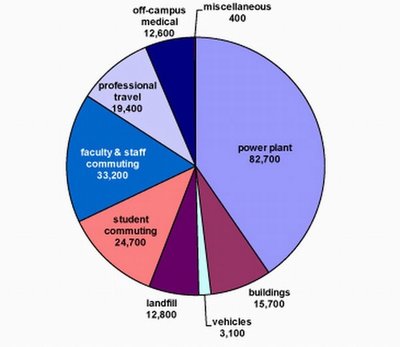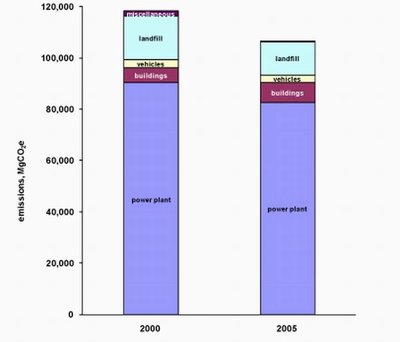February 5, 2009
UW seeks to deepen its commitment to sustainability
In the next two months, an energetic team of faculty, staff and students from all three campuses, coming together as the Climate Action Team, will be developing the first draft of a blueprint for deepening the UW’s commitment to sustainability.
Around the end of March, the team will release a draft Climate Action Plan, intended to sketch out the major issues and hard decisions that the UW must make if it is to become a carbon-neutral university and one that is increasingly emphasizing sustainability in its teaching and research.
As a founder on Sept. 15, 2007, the UW became a signatory to the Presidents’ Climate Commitment, by which the University agreed to develop policies that lead to climate neutrality as soon as possible, and to reduce greenhouse gases even while the long-term goals are being developed. Shortly thereafter, the Environmental Stewardship Advisory Council was established, led by Sandra Archibald, dean of the Evans School. Based on the council’s foundational work, the UW is primed to take on this large undertaking.
The good news, the team says, is that the UW already has an enviable track record in environmental stewardship. The boilers producing steam heat supplied to parts of the Seattle campus through the Power Plant were long ago converted from coal to natural gas. The UW has developed extensive efforts at energy conservation, saving millions of dollars. The UW’s innovative transportation management plan, commonly known as U-PASS, has received national recognition for reducing single-occupancy trips to campus. The UW began to construct energy-efficient buildings before the state passed laws requiring them. Housing and Food Services has an extensive array of plates, cutlery and cups that are compostable. The list goes on.
Part of the team’s work will be assembling in one place all the good things for the environment that the UW has done, and celebrating these achievements, most of which occurred without heavy-handed regulation. For example, the conversion of the Power Plant happened simply because Facilities Services thought that burning coal was a bad idea environmentally. And recycling began on campus largely because of the initiative of the ASUW.
That’s the good news. The not so good news, the team says, is that the UW already has grabbed the bulk of the low-hanging fruit. Innovations that were self-evident, required modest capital investments and paid off quickly have largely been done. The remaining challenges that would have the greatest impact are often either costly, hard to implement, or both.
Consider the Power Plant. It generates about 40 percent of the UW’s greenhouse gas emissions. “The issue,” says John Chapman, executive director of campus engineering and operations, “is how can we heat the campus in a carbon-neutral way?” This could require engineering innovations, or it could mean changing to boilers that are powered by a renewable energy source. In any case, the transition is likely to be pricey.
The other largest sources of carbon come from commuting and professional travel. Reducing these impacts is not easy, because they are the product of many individual decisions. Citizen education can play a role, but no one can determine in advance how successful such efforts might be. Longer term, it is possible that an increase in student housing on or near campus, and even the development of faculty/staff housing nearby, could change commuting patterns for some.
The UW’s facility at Pack Forest provides some intriguing possibilities. In establishing a carbon budget for the University, the facility has some distinctly positive aspects, as the trees actually sequester a not-insignificant quantity of carbon dioxide. But could those qualities be enhanced over the long run by more trees or a different mix of vegetation?
The team estimates that changes aside from big-ticket items might be able to reduce emissions by as much as 20 percent. These could include a green purchasing policy, further reducing waste in offices, making sure that nearly all lighting is through fluorescent lights and employing life-cycle cost factors in building construction.
“We have to choose our own date for achieving climate neutrality,” says Ruth Johnston, associate vice president of finance and facilities who heads the new Office of Environmental Stewardship and Sustainability, “although it’s entirely possible that the date may be constrained in the future by requirements at the state or federal level. This is an exciting project, but it’s also daunting because it’s so large.” She notes that, given the current economic climate, a key portion of the recommendations will include funding strategies.
One alternative available to the University in achieving carbon neutrality is to purchase “carbon offsets.” These are payments to a fund that is used to assist other organizations in reducing their carbon footprint. Most members of the action team regard this as the very last step to take, for addressing carbon emissions that cannot be reduced in a cost-effective manner.
The action team has divided into two subgroups, with one working on the operational issues of climate neutrality. The other is working on the academic issues of curriculum, research and outreach. Bruce Balick, professor of astronomy and an academic team leader, joined the Environmental Stewardship Advisory Committee last year. “If I am able to serve the university in just one way, I think helping it achieve sustainability would be the most important thing I could do,” he says. “We have to prepare our students to change the world or we won’t receive a passing grade on this action plan.”
Balick points out that a simple Web search shows a long list of UW courses that address climate change and sustainability. “We need to develop a plan for making these courses coherent. I expect that major progress will occur when the College of the Environment becomes operational next autumn.”
Balick would like to see faculty and students engaged in helping to solve the UW’s environmental challenges through original research. He cites the Power Plant dilemma as a situation which students and faculty in engineering might address. He’d also like to see teams working on how to provide a proper mix of incentives and disincentives for changing commuting habits that increase carbon emissions. “There are research opportunities across many fields,” he says. “Small projects on campus, funded with seed money, could lead to larger grants from the federal government and private foundations.” It is even possible that money for carbon neutral campus projects could come about through the federal economic stimulus package.
Balick also envisions the possibility of creating special lectureships on the subject of sustainability, which can help to inspire students as well as faculty. “The crisis is all about changing the way that we do many things,” he says. “We need to direct University-wide enthusiasm and committed people to areas that are in critical need of attention.”
The action team is mindful of the critical role that students can play, both in their daily choices and in advocating for change on campus. Aubrey Batchelor, a senior biochemistry major, is working as an intern in the Office of Environmental Stewardship and Sustainability. “I’m just thrilled about the idea of the University adopting a Climate Action Plan,” she says. “For the University to move forward despite the current economic constraints is inspirational. This provides a great example for other universities, and for the country.” Batchelor, who had been planning a career in genetics, is now reconsidering because of her exposure to environmental issues. “This has sparked something in me that I’d love to be involved with when I graduate.”
The Climate Action Team intends to engage the campus as the plan develops. The draft will be presented to the Environmental Stewardship Advisory Committee around the end of March, after which the campus community will be asked for input and comments. The plan will be published in mid-September. UW Tacoma and UW Bothell additionally will be developing their own action plans.


